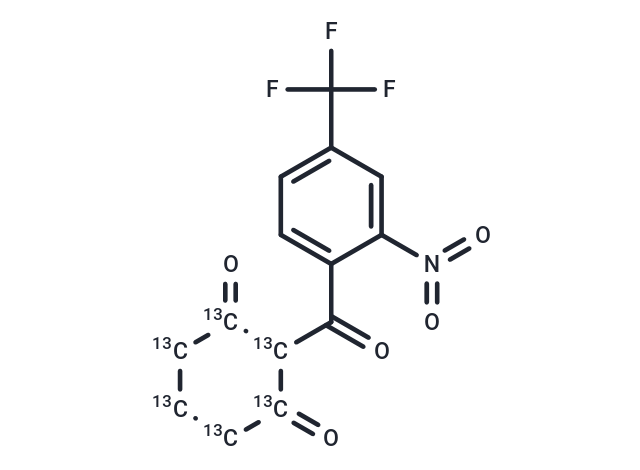- 全部删除
 您的购物车当前为空
您的购物车当前为空
Nitisinone-13C6
Nitisinone-13C6is intended for use as an internal standard for the quantification of nitisinone by GC- or LC-MS. Nitisinone is an inhibitor of 4-hydroxyphenylpyruvate dioxygenase (HPPD), which converts 4-hydroxyphenylpyruvate (HPPA) to homogentisate in the tyrosine catabolic pathway.1Nitisinone increases urinary levels of HPPA and 4-hydroxyphenyllactate (HPLA) in rats when administered at a dose of 10 mg/kg. Nitisinone (3 mg/kg) prevents the neonatal lethality of fumarylacetoacetate hydrolase (FAH) deficiency in mice when administered to pregnant dams.2It exhibits hepatoprotective effects inFAH-/-mice, such as prevention of increases in plasma levels of aspartate serine aminotransferase (AST) and conjugated bilirubin, when administration is continued following birth at a dose of 1 mg/kg. Nitisinone (100 μg) decreases urinary excretion of homogentisate and increases urinary excretion of HPPA, HPLA, and 4-hydroxyphenylacetate in a mouse model of alkaptonuria induced by ethylnitrosourea.3Formulations containing nitisinone have been used in the treatment of hereditary tyrosinemia type 1 (HT-1).

Nitisinone-13C6
Nitisinone-13C6is intended for use as an internal standard for the quantification of nitisinone by GC- or LC-MS. Nitisinone is an inhibitor of 4-hydroxyphenylpyruvate dioxygenase (HPPD), which converts 4-hydroxyphenylpyruvate (HPPA) to homogentisate in the tyrosine catabolic pathway.1Nitisinone increases urinary levels of HPPA and 4-hydroxyphenyllactate (HPLA) in rats when administered at a dose of 10 mg/kg. Nitisinone (3 mg/kg) prevents the neonatal lethality of fumarylacetoacetate hydrolase (FAH) deficiency in mice when administered to pregnant dams.2It exhibits hepatoprotective effects inFAH-/-mice, such as prevention of increases in plasma levels of aspartate serine aminotransferase (AST) and conjugated bilirubin, when administration is continued following birth at a dose of 1 mg/kg. Nitisinone (100 μg) decreases urinary excretion of homogentisate and increases urinary excretion of HPPA, HPLA, and 4-hydroxyphenylacetate in a mouse model of alkaptonuria induced by ethylnitrosourea.3Formulations containing nitisinone have been used in the treatment of hereditary tyrosinemia type 1 (HT-1).
| 规格 | 价格 | 库存 | 数量 |
|---|---|---|---|
| 1 mg | 待估 | 35日内发货 |
产品介绍
| 产品描述 | Nitisinone-13C6is intended for use as an internal standard for the quantification of nitisinone by GC- or LC-MS. Nitisinone is an inhibitor of 4-hydroxyphenylpyruvate dioxygenase (HPPD), which converts 4-hydroxyphenylpyruvate (HPPA) to homogentisate in the tyrosine catabolic pathway.1Nitisinone increases urinary levels of HPPA and 4-hydroxyphenyllactate (HPLA) in rats when administered at a dose of 10 mg/kg. Nitisinone (3 mg/kg) prevents the neonatal lethality of fumarylacetoacetate hydrolase (FAH) deficiency in mice when administered to pregnant dams.2It exhibits hepatoprotective effects inFAH-/-mice, such as prevention of increases in plasma levels of aspartate serine aminotransferase (AST) and conjugated bilirubin, when administration is continued following birth at a dose of 1 mg/kg. Nitisinone (100 μg) decreases urinary excretion of homogentisate and increases urinary excretion of HPPA, HPLA, and 4-hydroxyphenylacetate in a mouse model of alkaptonuria induced by ethylnitrosourea.3Formulations containing nitisinone have been used in the treatment of hereditary tyrosinemia type 1 (HT-1). |
| 别名 | Nitisinone-13C6 |
| 分子量 | 335.185 |
| 分子式 | C14H10F3NO5 |
| CAS No. | 1246815-63-3 |
| 密度 | no data available |
| 存储 | Powder: -20°C for 3 years | In solvent: -80°C for 1 year | Shipping with blue ice. |
| 溶解度信息 | Chloroform: Slightly soluble Ethyl Acetate: Slightly soluble |





 还可以
还可以

评论内容